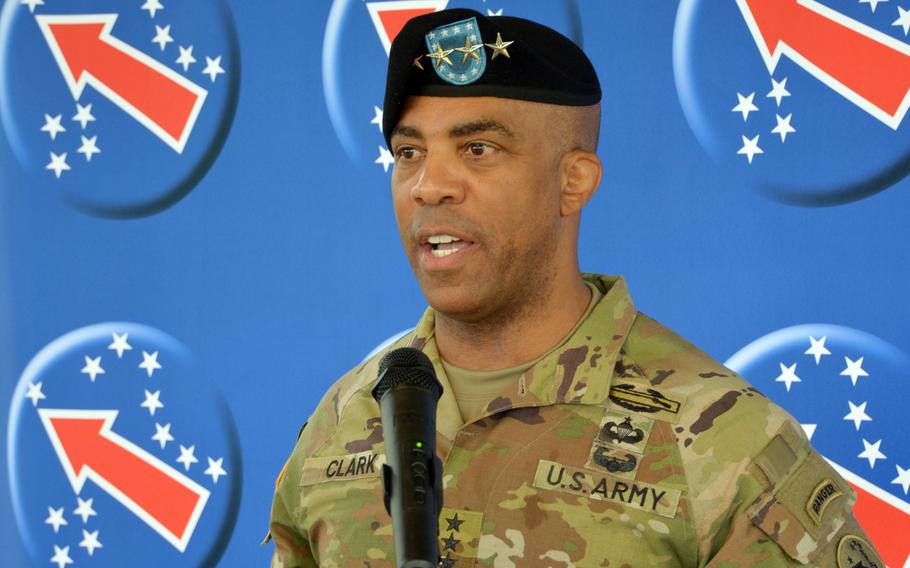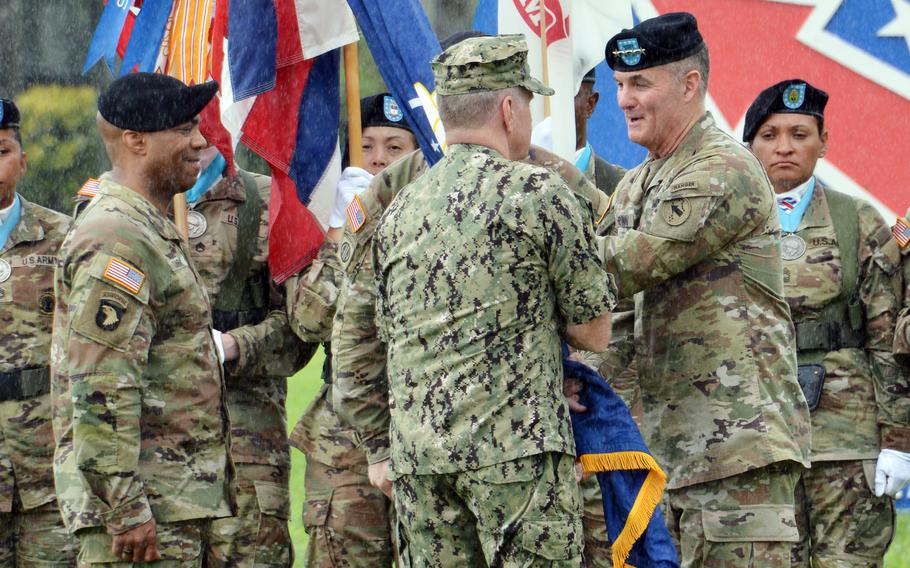
Gen. Ronald Clark speaks to reporters at Fort Shafter, Hawaii, on Nov. 8, 2024, shortly before taking command of U.S. Army Pacific. (Wyatt Olson/Stars and Stripes)
FORT SHAFTER, Hawaii — The newest commander of U.S. Army Pacific can trace by decades his roots in Hawaii.
“If you turn back the clock, our daughter, who was born at Tripler [Army Medical Center], is 30 now,” Gen. Ronald Clark said during a news conference at Fort Shafter on Friday, shortly before a ceremony in which he assumed command from Gen. Charles Flynn.
Flynn, who led the Pacific forces since 2021, is retiring after serving almost 40 years.
Clark was a company commander in the 25th Infantry Division at Schofield Barracks at the time his daughter was born. He returned to Hawaii years later to lead that entire division, followed by a stint as chief of staff at U.S. Indo-Pacific Command.
Most recently, Clark was the top military aide to Defense Secretary Lloyd Austin.
Clark’s move to Hawaii was briefly delayed in September when Sen. Tommy Tuberville placed a hold on his nomination. The Alabama Republican had questions concerning Clark’s role in the secrecy surrounding Austin’s hospitalization in January for complications arising from prostate cancer surgery. Tuberville dropped the hold after meeting with Clark.
“Welcome back to the operational world,” Adm. Samuel Paparo, head of U.S. Indo-Pacific Command, told Clark during an address at the ceremony.
Paparo deemed the West Point graduate “tailor made for this duty.”
“But you also know that the security environment has worsened since the last time you were here just three short years ago,” Paparo said.
“Given this dangerous security environment — the increasingly connected, transactional symbiosis of our would-be adversaries, [China’s] increasingly aggressive behavior, the increasing connections between Russia and North Korea — we need the team to be ready,” he said.
Paparo told Clark he is precisely the right leader for this assignment.
“And hand-picked,” he said. “We’ll value your strategic understanding of the global environment, your intimate knowledge of the Indo-Pacific.”

Gen. Charles Flynn, right, relinquishes command of U.S. Army Pacific as he hands the combatant command’s flag to Adm. Samuel Paparo, head of U.S. Indo-Pacific Command, at Fort Shafter, Hawaii, on Nov. 8, 2024. Gen. Ronald Clark, left, awaits assumption of command. (Wyatt Olson/Stars and Stripes)
Gen. Randy George, chief of staff of the Army and the highest ranking official to speak at the ceremony, also warned of rougher seas ahead.
“Today, our adversaries are working together to challenge us in every theater,” he said. “Russia, China, Iran and North Korea represent an axis of upheaval that is increasingly collaborating to threaten the free world. We understand how the battlefield is changing, and we have a sense of urgency about transforming our Army to meet the needs of our nation in today’s volatile operating environment.”
George credited Flynn with bolstering U.S. Army Pacific’s formation with its roughly 106,000 personnel stationed from Alaska and the West Coast to Japan and South Korea.
“Under Gen. Charlie Flynn’s leadership, USARPAC has transformed our expectations of what a theater army is capable of,” George said. “In the past four years, they have planned, coordinated and executed more than 200 bilateral and multilateral military exercises in more than 90 countries.”
Flynn’s oversight of the reflagging of units in Alaska as the 11th Airborne Division in 2022 demonstrated “organizational agility and commitment to dominating ground combat in the harsh terrain of the Arctic,” George said.
Under Flynn, the 3rd Multi-Domain Task Force was stood up in 2022, which aims to integrate and coordinate cyber, electronic warfare, intelligence and long-range weapons by land, air or sea.
Flynn also helmed the creation in 2022 of the Joint Pacific Multinational Training Center, which allows soldiers based in Hawaii and Alaska to undergo combat readiness training in their respective climates and terrain rather than at centers in Louisiana and California.
There is also a mobile version of the training center, which has been deployed to Indonesia and the Philippines.
George lauded the centers for enhancing the joint force’s relationships with militaries in allied and partner nations in the region.
“There is no better partner than the U.S. Army, and while our adversaries are increasingly working together, it is the troopers of U.S. Army Pacific who are continuously transforming to build lethal and cohesive teams that contribute to deterrence,” he said.